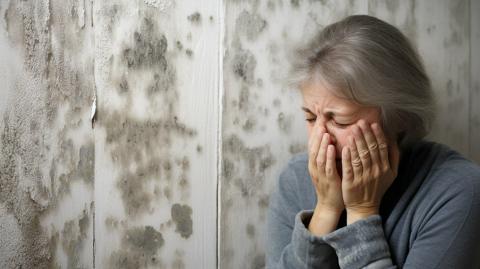
Damage caused by moisture to the respiratory system
Date |
19 Dec 2023
Exposure to excess moisture or high humidity can have several adverse effects on the respiratory system. Here are some potential issues:
- Mold Growth: Moisture promotes the growth of mold, which can release spores into the air. Inhalation of mold spores can irritate the respiratory system, leading to symptoms such as coughing, wheezing, and difficulty breathing. Individuals with allergies or asthma may be particularly sensitive to mold.
- Dust Mites: High humidity creates an ideal environment for dust mites to thrive. These microscopic organisms can trigger allergic reactions and worsen respiratory conditions, causing symptoms like sneezing, nasal congestion, and coughing.
- Bacterial Growth: Moist conditions can also facilitate the growth of bacteria. Breathing in air contaminated with bacteria can lead to respiratory infections, which may manifest as symptoms ranging from mild respiratory discomfort to more severe conditions like pneumonia.
- Aggravation of Respiratory Conditions: People with pre-existing respiratory conditions, such as asthma or chronic obstructive pulmonary disease (COPD), may experience worsened symptoms in humid environments. High humidity can make it more difficult for individuals with these conditions to breathe comfortably.
- Viral Infections: Excessive moisture can create conditions conducive to the survival and transmission of viruses. Respiratory viruses, such as the flu or common cold viruses, may spread more easily in environments with high humidity.
Certainly, Bashiti Stores We will show you some solutions to address the harmful effects of excess moisture or high humidity on the respiratory system:
- Dehumidifiers: Use dehumidifiers to reduce and maintain optimal humidity levels in indoor spaces. Keeping humidity levels between 30-50% can help prevent mold growth, dust mites, and bacterial proliferation.
An example of it " Bison MOISTURE ABSORBENT DEVICE" . - Ventilation: Ensure proper ventilation in your home by using exhaust fans in areas prone to moisture, such as bathrooms and kitchens. Opening windows and doors to promote air circulation can also help reduce humidity levels.
- Regular Cleaning: Regularly clean and dust your home to prevent the accumulation of mold, dust mites, and other allergens. Pay attention to areas that are more susceptible to moisture, such as basements and crawl spaces.
- Address Leaks and Water Damage: Promptly repair any leaks in the roof, walls, or plumbing to prevent water damage and mold growth. Ensure that the building structure is well-maintained to prevent moisture intrusion.
- Use Air Purifiers: Consider using air purifiers with HEPA filters to remove airborne particles, allergens, and contaminants, promoting cleaner air and better respiratory health.
- Monitor Indoor Plants: While plants can improve air quality, too many indoor plants can contribute to high humidity. Be mindful of the number and type of plants in your living space.
- Proper Storage: Store items susceptible to moisture, such as clothes, books, and linens, in dry and well-ventilated spaces. Consider using moisture-absorbing products in closets or storage areas.
- Regular HVAC Maintenance: Ensure that your heating, ventilation, and air conditioning (HVAC) systems are well-maintained. Change filters regularly to prevent the buildup of dust and mold in the system.
- Educate Yourself: Learn about the specific triggers and allergens that may affect respiratory health in your environment. Being informed allows you to take proactive measures to minimize risks.
- Seek Professional Help: If you experience persistent respiratory symptoms or suspect mold or other issues in your home, consult with professionals, such as HVAC specialists or mold remediation experts, to assess and address the problem.

